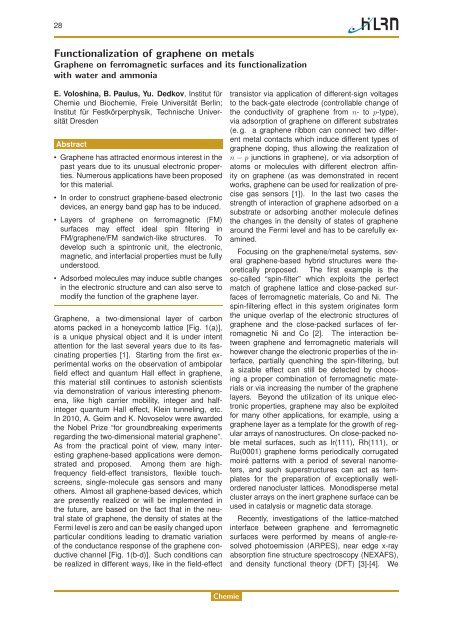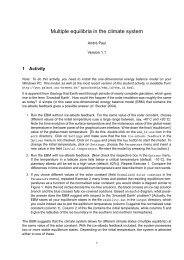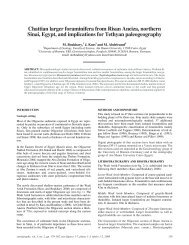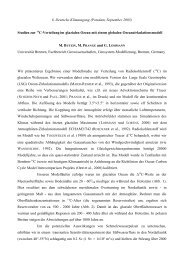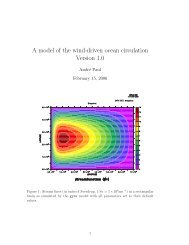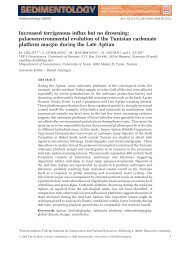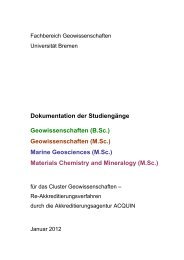Forschung im HLRN-Verbund 2011
Forschung im HLRN-Verbund 2011
Forschung im HLRN-Verbund 2011
- Keine Tags gefunden...
Erfolgreiche ePaper selbst erstellen
Machen Sie aus Ihren PDF Publikationen ein blätterbares Flipbook mit unserer einzigartigen Google optimierten e-Paper Software.
28Functionalization of graphene on metalsGraphene on ferromagnetic surfaces and its functionalizationwith water and ammoniaE. Voloshina, B. Paulus, Yu. Dedkov, Institut fürChemie und Biochemie, Freie Universität Berlin;Institut für Festkörperphysik, Technische UniversitätDresdenAbstract• Graphene has attracted enormous interest in thepast years due to its unusual electronic properties.Numerous applications have been proposedfor this material.• In order to construct graphene-based electronicdevices, an energy band gap has to be induced.• Layers of graphene on ferromagnetic (FM)surfaces may effect ideal spin filtering inFM/graphene/FM sandwich-like structures. Todevelop such a spintronic unit, the electronic,magnetic, and interfacial properties must be fullyunderstood.• Adsorbed molecules may induce subtle changesin the electronic structure and can also serve tomodify the function of the graphene layer.Graphene, a two-d<strong>im</strong>ensional layer of carbonatoms packed in a honeycomb lattice [Fig. 1(a)],is a unique physical object and it is under intentattention for the last several years due to its fascinatingproperties [1]. Starting from the first exper<strong>im</strong>entalworks on the observation of ambipolarfield effect and quantum Hall effect in graphene,this material still continues to astonish scientistsvia demonstration of various interesting phenomena,like high carrier mobility, integer and halfintegerquantum Hall effect, Klein tunneling, etc.In 2010, A. Ge<strong>im</strong> and K. Novoselov were awardedthe Nobel Prize “for groundbreaking exper<strong>im</strong>entsregarding the two-d<strong>im</strong>ensional material graphene”.As from the practical point of view, many interestinggraphene-based applications were demonstratedand proposed. Among them are highfrequencyfield-effect transistors, flexible touchscreens,single-molecule gas sensors and manyothers. Almost all graphene-based devices, whichare presently realized or will be <strong>im</strong>plemented inthe future, are based on the fact that in the neutralstate of graphene, the density of states at theFermi level is zero and can be easily changed uponparticular conditions leading to dramatic variationof the conductance response of the graphene conductivechannel [Fig. 1(b-d)]. Such conditions canbe realized in different ways, like in the field-effecttransistor via application of different-sign voltagesto the back-gate electrode (controllable change ofthe conductivity of graphene from n- to p-type),via adsorption of graphene on different substrates(e. g. a graphene ribbon can connect two differentmetal contacts which induce different types ofgraphene doping, thus allowing the realization ofn − p junctions in graphene), or via adsorption ofatoms or molecules with different electron affinityon graphene (as was demonstrated in recentworks, graphene can be used for realization of precisegas sensors [1]). In the last two cases thestrength of interaction of graphene adsorbed on asubstrate or adsorbing another molecule definesthe changes in the density of states of graphenearound the Fermi level and has to be carefully examined.Focusing on the graphene/metal systems, severalgraphene-based hybrid structures were theoreticallyproposed. The first example is theso-called “spin-filter” which exploits the perfectmatch of graphene lattice and close-packed surfacesof ferromagnetic materials, Co and Ni. Thespin-filtering effect in this system originates formthe unique overlap of the electronic structures ofgraphene and the close-packed surfaces of ferromagneticNi and Co [2]. The interaction betweengraphene and ferromagnetic materials willhowever change the electronic properties of the interface,partially quenching the spin-filtering, buta sizable effect can still be detected by choosinga proper combination of ferromagnetic materialsor via increasing the number of the graphenelayers. Beyond the utilization of its unique electronicproperties, graphene may also be exploitedfor many other applications, for example, using agraphene layer as a template for the growth of regulararrays of nanostructures. On close-packed noblemetal surfaces, such as Ir(111), Rh(111), orRu(0001) graphene forms periodically corrugatedmoiré patterns with a period of several nanometers,and such superstructures can act as templatesfor the preparation of exceptionally wellorderednanocluster lattices. Monodisperse metalcluster arrays on the inert graphene surface can beused in catalysis or magnetic data storage.Recently, investigations of the lattice-matchedinterface between graphene and ferromagneticsurfaces were performed by means of angle-resolvedphotoemission (ARPES), near edge x-rayabsorption fine structure spectroscopy (NEXAFS),and density functional theory (DFT) [3]-[4]. WeChemie


